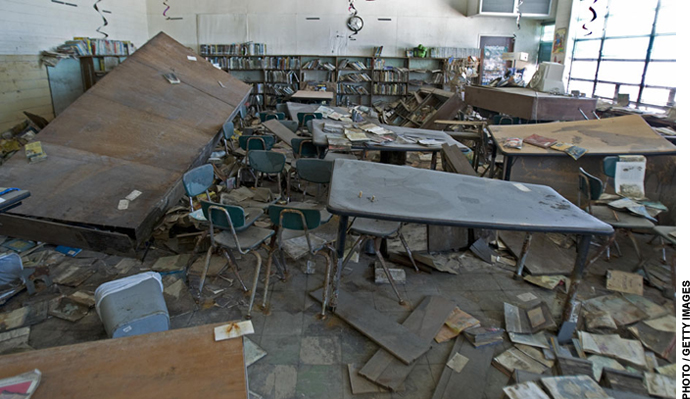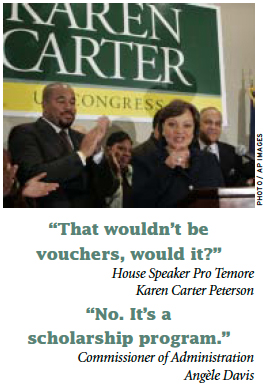Video: Michael Henderson talks with Education Next
 Voucher programs and their supporters have had a tough last few years. The Florida Supreme Court declared vouchers in that state unconstitutional in 2006. Three years later, the Arizona Supreme Court did the same. In 2007, voters in Utah handed a resounding defeat to a voucher program there. In 2009, the U.S. Congress refused to continue funding the federal voucher program in Washington, D.C., effectively killing the program in the nation’s capital.
Voucher programs and their supporters have had a tough last few years. The Florida Supreme Court declared vouchers in that state unconstitutional in 2006. Three years later, the Arizona Supreme Court did the same. In 2007, voters in Utah handed a resounding defeat to a voucher program there. In 2009, the U.S. Congress refused to continue funding the federal voucher program in Washington, D.C., effectively killing the program in the nation’s capital.
The Louisiana legislature stood apart from this trend and in the summer of 2008 passed Student Scholarships for Educational Excellence, the state’s first voucher program, specifically for New Orleans. In the fall, 870 students in kindergarten through 3rd grade whose families earned less than two and a half times the federal poverty level and who would otherwise attend some of the worst schools in the city received vouchers worth up to $6,000 to attend private schools of their choice. In the second year, 2009–10, the maximum voucher amount rose to more than $7,000. The number of students receiving vouchers increased to 1,324. Thirty-one private schools, most of them parochial, in Orleans Parish and neighboring Jefferson Parish serve these students. As was the case before Hurricane Katrina (see “Hope after Katrina,” feature, Fall 2006), private schools educate about one-third of the students in Orleans Parish (see Figure 1).
How did the Louisiana legislature pass this proposal when so many other states were rejecting similar programs? At first glance the question may not seem particularly interesting. After all, Louisiana is seen as the perennial exception to the general rule of American political culture. The state’s most famous political personality and a uniquely Louisianan character, Huey P. Long, once described himself as sui generis, one of a kind. The moniker is as fitting to the land of Long as to the man himself. On top of that, Hurricane Katrina brought unprecedented physical destruction, demographic shifts, and economic impacts that reshaped state and local politics as well.
In fact, passage of House Bill 1347, which established the Student Scholarships for Educational Excellence Program, depended on many factors, only some of which can be traced to Hurricane Katrina. The legislative success of the program was more a political story than a fluke of geography or history.
“In a way we’ve never done before”
Policy innovation comes slowly along the muddy banks of the Mississippi River. Frequently, it seems only an external catalyst (federal civil-rights enforcement, international fluctuations in the price of oil, or floodwaters) can spur new approaches to the social and economic challenges that have long faced New Orleans. The city’s Old World persona has frustrated the reformer at least as much as it has intrigued the tourist.
School governance is no exception. Prior to Hurricane Katrina, the Orleans Parish School Board (OPSB) was the strongest board politically in the state. It oversaw the largest district, the most students, and the biggest budget. It employed more teachers and staff than any other district, a ready resource for phone calls and letters directed at state officials. Its boundaries overlapped with 15 seats in the Louisiana House of Representatives and another 7 in the Senate, representing about 15 percent of the legislature, far more than any other school district. New Orleans was also home to the state’s strongest teachers union, United Teachers of New Orleans (UTNO). In the 1970s, it was the first teachers union in the Deep South (and the only one in Louisiana) to win collective bargaining rights.
But the political clout of the OPSB and UTNO was not matched with a will for reform. When the Louisiana legislature proposed to address the state’s troubled schools in the 1990s with a series of policy innovations—charter schools, school accountability, and high-stakes testing—the OPSB and UTNO (occasionally even the New Orleans City Council) opposed the changes at each turn. A decade later, when the state sought to tighten fiscal oversight over the district, the OPSB balked, despite having lost track of millions of federal dollars and facing bankruptcy.
Meanwhile, public school enrollment steadily declined, dropping by more than 30,000 students over 30 years. Those students who remained attended some of the nation’s worst schools. Nearly two-thirds of the district’s schools were identified as “academically unacceptable,” the state’s lowest performance category. Only 12.5 percent of schools statewide received that designation.
Reform would have to come from outside. As House Bill 1347 approached passage in 2008, a representative from New Orleans stood on the House floor desperately urging his colleagues to delay the final vote, “We are spending $10 million on 1,500 students in a way we’ve never done before!”
He was correct. The legislature had rejected some 20 voucher proposals in the 10 years leading up to the 2008 legislative session. In 2005, a voucher proposal survived a hearing in the House Education Committee and passed the entire House. The Senate Education Committee put a stop to its progress, defeating it by one vote.
Voucher proposals were defeated because a persistent legislative coalition opposed them. Urban legislators tend to be mostly black Democrats from within the cities of New Orleans, Baton Rouge, and Shreveport. Legislators from the more affluent areas in and around the state’s cities tend to be white Republicans. Rural and small-town legislators are mostly conservative white Democrats and Republicans. How these groups pair off spells the fate of most any legislative proposal.
Almost without exception, suburban Republicans support urban vouchers, and urban Democrats oppose them. As a result, the stance of rural and small-town legislators has been decisive on the issue. They represent districts that are spread over large geographic areas and are typically not situated neatly within radio and television markets. Legislators from these areas build strong ties with local officials—sheriffs, parish (county) government officials, and school board members—who provide name recognition, organization, and personal contact with their constituents. Rural legislators pay particularly close attention to the interests of these officials and to groups that lobby on their behalf, such as the Louisiana School Boards Association.
Opposition to vouchers was particularly acute in rural northern Louisiana, which has relatively few private schools. Most of the state’s private schools are Catholic institutions in southern Louisiana. Critics would, therefore, cast vouchers as a handout to the majority Catholic south, an unappealing prospect in the majority Baptist north. With their constituents uneasy about vouchers and their political allies on local boards actively opposing all such programs, these legislators opposed the proposals and the bills died.
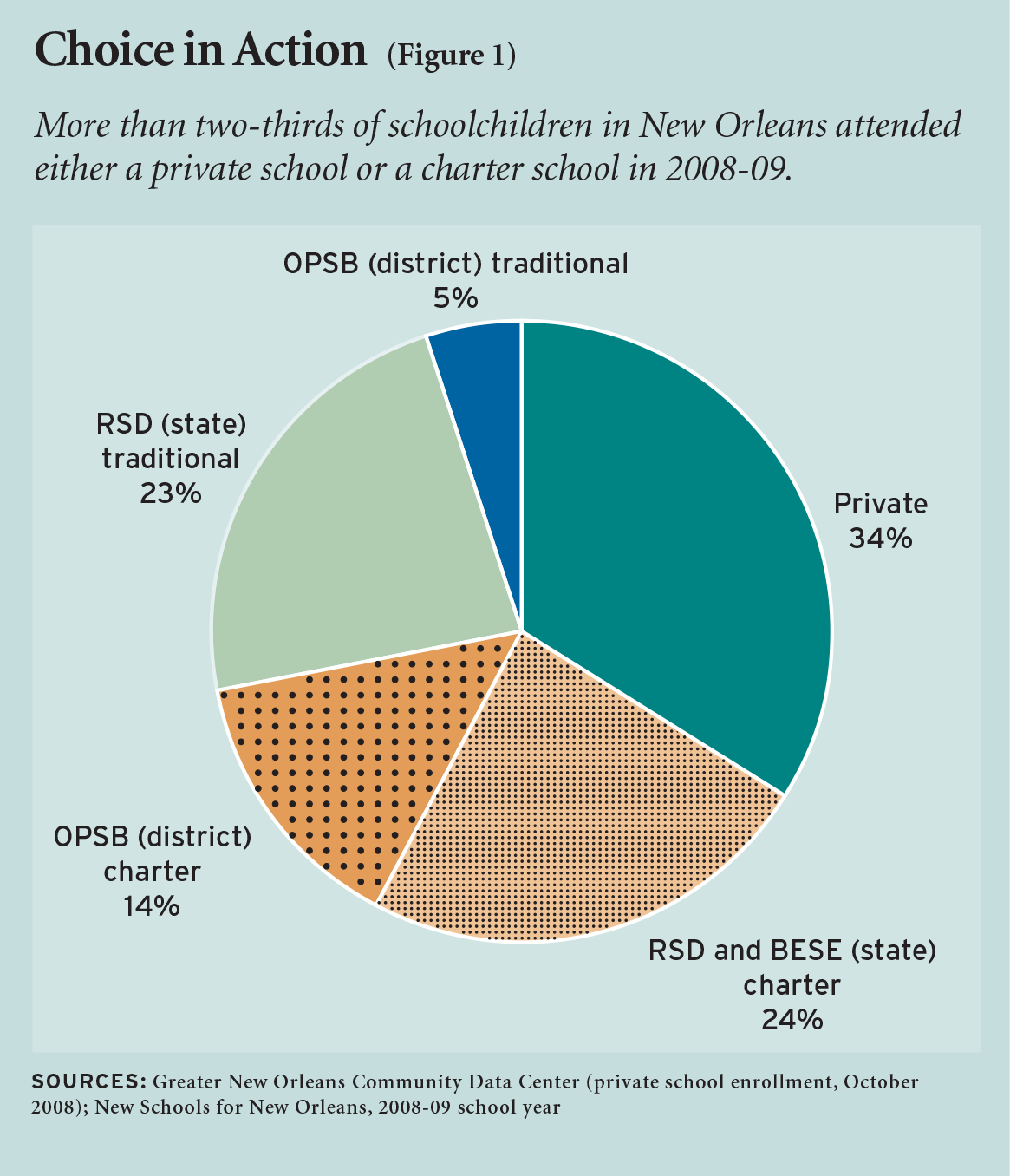
Hurricane Katrina
What made 2008 different? The easy answer is Hurricane Katrina. The storm wiped out the status quo. On the first day of the 2005–06 school year, more than 100 public schools served 65,000 students under the purview of the OPSB. Then the storm damaged or destroyed two-thirds of the district’s school buildings, an estimated loss of $800 million. It also dispersed tens of thousands of New Orleans residents throughout the country. When the school year ended, only a handful of public schools had reopened, serving fewer than one-fifth as many students as had begun the year. To recover from such devastation, the city of New Orleans needed help from the state to restore infrastructure, homes, places of business, and schools.
The need for rebuilding opened up the opportunity for reform. “We’re not going to simply re-create the schools of New Orleans,” then governor Kathleen Blanco announced in her first speech following the storm. “Tonight, I am calling on all Louisianans and all Americans to join an historic effort to build a world-class, quality system of public education in New Orleans. Our children who have weathered this storm deserve no less.” She called the legislature into special session and requested authorization for state takeover of schools in New Orleans. The legislation easily passed, and the Louisiana Department of Education took over all but the handful of top-performing schools in the city. Today, the OPSB runs only 5 schools and the state runs 30. A majority of public school students attend the 40 charter schools. Whether district-run, state-run, or charters, all of these schools operate under a system of public choice without attendance zones.
Damaged as much by revelations of its own misdeeds as by the hurricane and state takeover, the OPSB has become politically obsolete. Likewise, UTNO was decimated. In August 2005, before Hurricane Katrina, the union claimed more than 7,000 members among the district’s teachers and support personnel. Lacking schools to staff, the OPSB terminated all teachers and education personnel in January 2006. UTNO filed suit the next day to force the district to reopen more schools. More unsuccessful suits followed, for back pay, disaster pay, lost sick days, and employee-paid health care and pension contributions. When the collective bargaining agreement expired in June 2006, the OPSB declined to renew it.
So if the storm brought state takeover and dramatic expansion of charter schools to New Orleans, did it also bring vouchers? On its own, Hurricane Katrina cannot explain it. In the weeks after the storm, the superintendent of schools for the Archdiocese of New Orleans appeared before the Board of Elementary and Secondary Education (BESE) urging board members to consider using vouchers as a way for the state and Catholic schools to collaborate in serving the students who remained in the city. BESE declined. Later, when Governor Blanco called the legislature into special session (twice) to address the crisis, vouchers were not on her agenda. In the spring of 2006, when the legislature held its first regular session after the hurricane, it killed three voucher proposals.
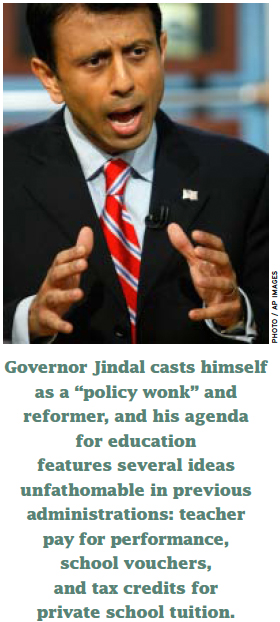 “If Bobby Jindal gets elected”
“If Bobby Jindal gets elected”
Passage of a voucher bill required political change. That change came in the fall of 2007 when Bobby Jindal, a Republican and strong supporter of vouchers, was elected governor. Thirty-six at the time, Jindal is one of the state’s youngest governors. But he has a long résumé: Rhodes scholar, a stint at McKinsey & Company, secretary of the Louisiana Department of Health and Hospitals, president of the University of Louisiana System, assistant secretary at the U.S. Department of Heath and Human Services, and member of the U.S. House of Representatives for the 1st District of Louisiana, a suburban district outside New Orleans and the geographic base of the state’s Republican Party.
Jindal casts himself as a “policy wonk” and reformer, and his agenda for education features several ideas unfathomable in previous administrations: teacher pay for performance, school vouchers, and tax credits for private school tuition. Proponents of these proposals saw promise in Jindal. Just days before the vote, Howard Fuller, founder of the Black Alliance for Educational Options (BAEO) and a strong supporter of vouchers, told national reporters, “If Bobby Jindal gets elected, I think we have a chance to do something in Louisiana.”
“A few green stamps to spend”
Jindal had help from a 12-year-old term-limits law that changed the face of the legislature in 2007. Sixty of the 105 districts in the House had open-seat elections. Eighteen of 39 Senate seats were also vacant. Although 15 seats were filled by incumbents from one chamber running for election in the other, the vast majority of open seats were filled by first-time legislators. This massive influx of new blood marked the largest turnover in the Louisiana legislature since Reconstruction. The turnover changed the prospects for voucher legislation.
Most important, Republicans increased their numbers. Louisiana has been trending Republican for decades as Republicans replaced retiring Democrats, but the process was slow. When term limits forced the retirement of 60 incumbents, most of whom were Democrats, Republicans saw the largest boost in their legislative ranks in over 100 years. This increased Jindal’s base of support. But Republicans still fell short of a majority: 48 percent in the House and 42 percent in the Senate. A party-line vote would defeat the bill. Governor Jindal needed Democrats as well.
The governor initially sought to build a biracial coalition between white Republicans and black Democrats. A similar coalition had passed vouchers in Wisconsin 20 years before. Jindal was not so fortunate. The Legislative Black Caucus consists almost entirely of Democrats, and its membership overlaps significantly with the Orleans delegation. Although a few members have been prominent supporters of charter school expansion, the group has tended to support traditional public-school interests like greater funding for struggling schools and pay raises for teachers rather than choice proposals. The 2008 session was no different. With the Black Caucus opposed, the few black legislators’ “Yea” votes Jindal secured were not enough to change the outcome. However, he managed to transform the image of the proposal’s supporters. For the first time, black legislators from New Orleans, Rep. Austin Badon and Sen. Ann Duplessis, sponsored the voucher bill. All of the previous attempts (even those specifically aimed at the majority black school system in New Orleans) had been sponsored by white Republicans.
Similarly, the most prominent organizations to lobby in support of these proposals, the Archdiocese of New Orleans and the Louisiana Association of Business and Industry, were represented by whites. In 2008 these organizations took a backseat. Instead, most testimony in support of the bill came from BAEO. During one key committee hearing, national and state leaders of BAEO were accompanied by two teenagers from Desire Street Academy, a private school in the New Orleans Ninth Ward. The students spoke about how attending a private school changed their lives, reflecting on the cousins, friends, and neighbors who lacked this opportunity. Each closed his comments with the phrase, “We can’t wait.” For the first time, supporters represented the population to which the bill was directed.
Still short of votes, Jindal turned to conservative white Democrats from the state’s small towns and rural areas. Local school board members and superintendents had yet to establish alliances with their new legislators. For freshman legislators, the most powerful source of political power was not the local school board; it was the new governor. When he offered to work with them on legislation to help their constituents, they were willing to listen to his agenda.
Soon Jindal had lined up votes from even the most unlikely supporters. For example, Rep. Noble Ellington Jr., a Democrat from the small northern community of Winnsboro, had opposed vouchers for more than a decade. In 2008 he had a change of heart or at least a change of vote. Ellington told reporters that he would vote for the bill because he was “willing to work with the governor as long as he is willing to work with me on things in my district.” Another northern Louisiana representative captured the political situation during debate in the House Education Committee, “We have a governor who is very interested….The administration has a few green stamps to spend.”
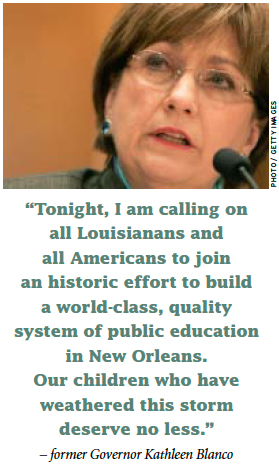 “What has changed is the frame”
“What has changed is the frame”
The administration still had to provide legislators with the necessary political cover to explain their votes back home and so crafted the legislation in the most amenable terms possible. The term voucher is conspicuously absent from the 11-page act. Its official title is the Student Scholarships for Education Excellence Program. The bill’s supporters took care to use the term “scholarship” in all their discussions of the bill. House Speaker Pro Tempore Karen Carter Peterson, a prominent opponent, first noticed a reference to the program during a routine review of the governor’s proposed budget several weeks before the legislative session began. “That wouldn’t be vouchers would it?” she asked Commissioner of Administration Angèle Davis. “No. It’s a scholarship program,” Davis replied.
Opponents tried to reclaim the lead on framing the issue. During the House Education debate two months after Peterson’s exchange with Davis, Steve Monaghan, president of the Louisiana Federation of Teachers, declaring “what has changed is the frame,” described the program as camouflaged vouchers. But the bill’s language remained intact and allowed legislators to tell their constituents that they had voted for “scholarships.”
The administration also won the spin battle over the measure’s cost, paying careful attention to how the bill treated the state’s education funding formula, the Minimum Foundation Program (MFP), the main source of state support for districts and a sacred cow in the statehouse. No legislator wants to be charged with cutting funds for children.
Jindal set aside $10 million for the program from the state’s general fund, rather than from dollars reserved for the MFP. Opponents argued that the bill would still reduce MFP dollars for New Orleans indirectly, as the formula is based on enrollment in public schools. But since the official enrollment counts for the MFP are conducted at the end of the school year (to determine dollars for the following year), any indirect impact on MFP funding from the voucher program was delayed for a year after the bill’s passage. Legislators who supported the bill could tell their constituents that they did not cut the MFP.
Finally, in crafting a proposal that would affect only New Orleans, the administration gave legislators additional political cover. Those who might oppose vouchers in their own districts could support them for New Orleans. In the end, the language of the bill permitted the administration to tell legislators (who could then tell their constituents) that the scholarships would not harm the MFP and would not affect schools in their own districts.
The administration’s strategy to keep the bill’s profile low also helped secure passage. Except for Rep. Peterson’s exchange with Commissioner Davis in February, there were only rumors about a $10 million scholarship program. Neither Jindal’s fall campaign nor his inaugural address made an issue of vouchers. The governor never mentioned the proposal until his speech to open the legislative session in late March. Even then, the 49 words devoted to the program (out of a 4,000-word speech mostly dedicated to education issues) offered no details. Voucher opponents remained in the dark until the bill was filed one week into the session. By then, much of the administration’s work to line up votes was complete.
The administration further avoided early grass-roots opposition in New Orleans by navigating around the rules for “local” bills, a tactic that had been employed previously in Cleveland and Milwaukee. In Louisiana, bills that affect only a single community must be filed before the session begins and must be advertised in the community they will affect. The administration avoided the “local” designation by singling out New Orleans only indirectly. The bill applied to school districts with a population greater than 475,000 as of the 2000 census. Only Orleans Parish meets this criterion.
The bill received only modest press attention. There was no barrage of advertisements urging citizens to contact their representatives. One exception was a radio spot aired in New Orleans criticizing Rep. Peterson for her opposition to the scholarship program. Interest groups did not mobilize supporters or opponents to gather on the capitol steps or in the streets of New Orleans. BAEO was an exception, but its efforts were aimed more at recruiting students and parents to testify at the committee hearing than at organizing public rallies.
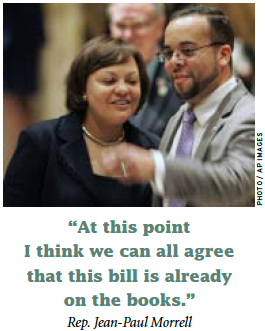 “This bill is already on the books”
“This bill is already on the books”
The only close vote came in the bill’s first test. The 17-member House Education Committee heard the bill in late April. All but five members had begun their first term only six months before and were hearing the debate for the first time. Rep. Peterson joined the committee for the hearing. As Speaker Pro Tempore, she has the right to participate in any committee hearing but cannot vote. After three and a half hours of testimony and debate, all six Republicans on the committee voted for the bill. The bill’s sponsor, Rep. Badon, who was also the committee’s vice chairman, voted for the bill, but the other five black representatives on the committee voted against, along with a white Democrat from New Orleans. The bill’s fate depended on the remaining five white Democrats who represented smaller towns throughout the state. Three of them voted against but two voted in support. The bill passed committee 9 to 8, with Rep. Peterson sitting on the sidelines unable to cast the vote that would have kept the bill from moving forward.
When the bill returned to the House floor in mid-May, Rep. Jean-Paul Morrell (D-New Orleans) opposed it but conceded, “At this point I think we can all agree that this bill is already on the books.” The only shot at defeat was to stall until the legislature was required to close the session in June. Rep. Peterson moved to send the bill to House Appropriations, ostensibly because it required a $10 million appropriation. The motion failed.
In the Senate Education Committee, the debate was limited to amendments dealing with implementation: how long private schools had to operate before participating, what tests students receiving vouchers would have to take, what agency would be responsible for the costs of auditing the program.
Opponents took on an air of resignation. The New Orleans Times-Picayune, one of the most prominent papers in the state, had run an editorial condemning the bill in May. By June, editors could read the writing on the wall and in their pages argued for “strengthening” the bill (i.e., amending the accountability provisions) rather than defeating it.
The amendments gave opponents their final chances at running down the clock. The bill was next heard in the Senate Finance Committee, where Sen. Edwin Murray (D-New Orleans) repeatedly asked the chairman, Sen. Mike Michot (R-Lafayette), to table the bill while the committee members took time to digest the amendments. Michot, noting the dwindling number of days left in the session, declined.
The bill returned to the House floor on June 18 for concurrence in the Senate amendments. Only five days remained in the legislative session. The House could concur in the amendments, effectively passing the bill, or reject them. Supporters voted to concur in the amendments and send the bill to the governor’s desk immediately.
The bill passed the House 62 to 34, with eight representatives recorded as absent. Almost every Republican voted for the bill and all but six members of the Legislative Black Caucus opposed it. White Democrats cast the deciding votes; urban and suburban white Democrats voted with their Republican peers. Rural Democrats split for and against the bill in almost even numbers, but this was far more support than any previous bill had found from these legislative districts. The bill passed in large part because the governor had won over more rural white Democrats than anyone had before (see Figure 2).
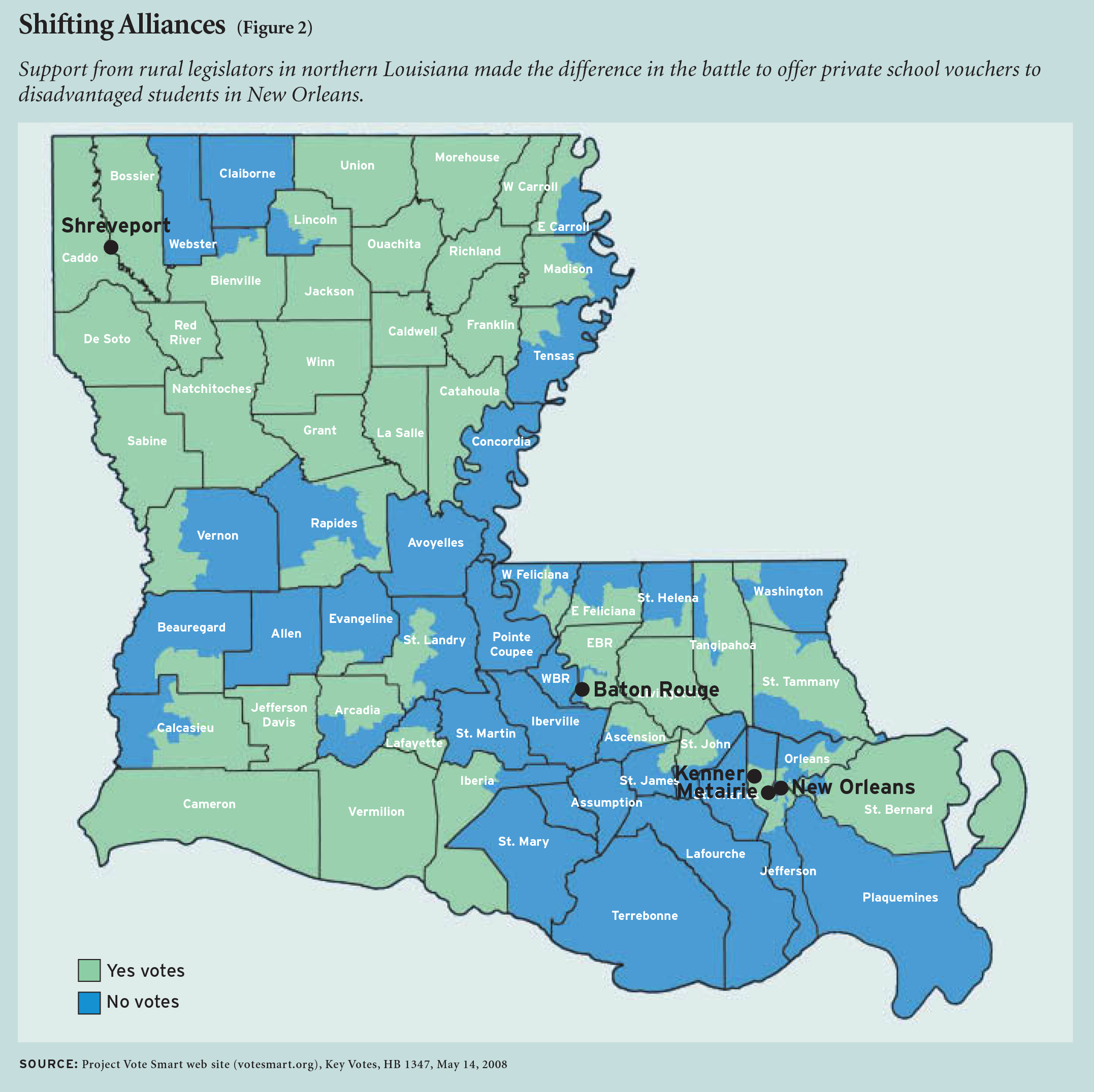
Beyond Sui Generis
So far, the program has survived legally and politically (see sidebar). But was passage of the Louisiana voucher program a fluke arising from situations just too unique to replicate elsewhere? Or does it offer more general lessons about the politics of school choice? The fact that the program came so close on the heels of Hurricane Katrina seems to suggest the former. The storm set the stage, raising the salience of education reform and crippling some traditional political opponents. Perhaps most important, it wiped out the political strength of the local teachers union, an occurrence unlikely to be repeated elsewhere.
But once the stage was set, the political dynamics were not so uniquely Louisianan. Passage of House Bill 1347 ultimately depended on the votes of rural legislators unaccustomed to supporting vouchers. Winning over those votes depended on a popular governor committed to expanding choice, his willingness to put his political capital to work for the proposal’s success, and adept navigation of the legislative process. This is where voucher supporters found their greatest asset: a popular governor committed to school choice. Supporters did not have to lobby the governor for support; he was a supporter already. Instead, they could simply assist him in lobbying the legislature. The critical lesson for proponents outside the Bayou State seems to be: Get strong voucher supporters elected.
The political story of every reform will have some unique features. In New Orleans, the critical factors in establishing vouchers were 1) the weakened union presence; 2) parent-based lobbying support; 3) new faces in the legislature; and 4) strong gubernatorial support. Except perhaps for the first of these, none is too uniquely Louisianan to be inimitable.
Michael Henderson, a native of Louisiana, is research fellow at Harvard University’s Program for Education Policy and Governance and graduate student in the Department of Government.
So Far, So Good
Student Scholarships for Educational Excellence has not been challenged in court, which may be a feature of the state’s atypical constitution. Voucher programs are typically challenged based on a constitutional clause that either bars use of public funds to support sectarian schools or prohibits compelling individuals to support religious institutions without their consent. Louisiana is one of only three states with neither type of clause in its constitution. Thus it appears unlikely to face defeat in the state courts. In the legislature, supporters will have to regroup on an annual basis: Although the law authorizing the program remains on the books, its appropriation must be renewed each year. Given that the initial appropriation was far more than was needed for the first year, the second-year reduction need not be taken as an ill omen for the program’s future prospects.
It is not yet clear how the program will affect student achievement in New Orleans. The law requires that students who receive vouchers take the state tests, known as LEAP and iLEAP, yet so far few test score data are available. The state’s accountability testing begins in 3rd grade, so only one grade of voucher students took the tests the first year. Further, the state only requires schools with at least 10 students in a given grade to report scores publicly for that grade. Only three of the schools that accepted voucher students in the program’s first year enrolled 10 ormore 3rd graders. Early in the second year, the testing requirement was expected to apply to eight schools.


